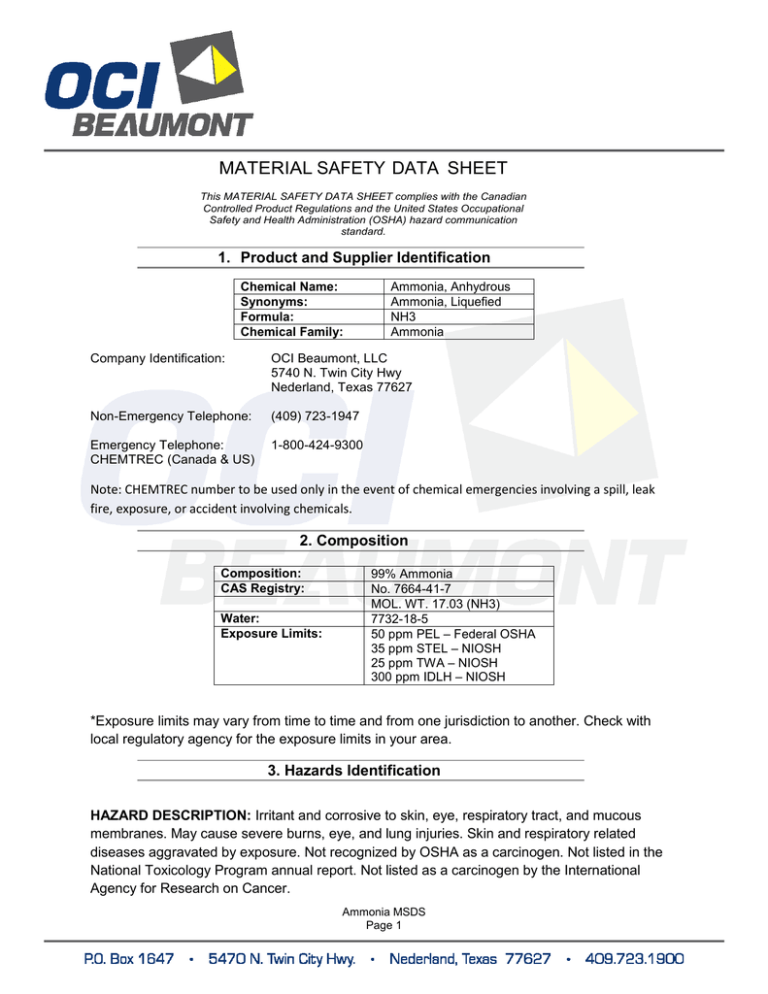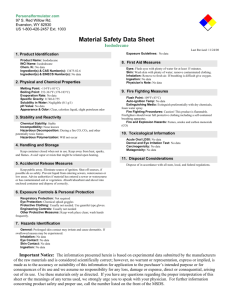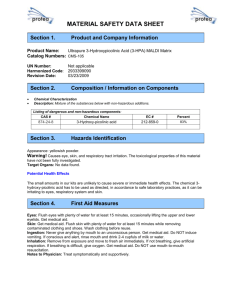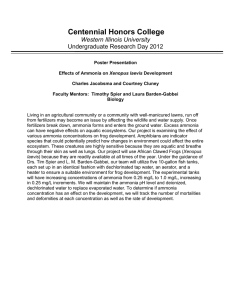MATERIAL SAFETY DATA SHEET
advertisement

MATERIAL SAFETY DATA SHEET This MATERIAL SAFETY DATA SHEET complies with the Canadian Controlled Product Regulations and the United States Occupational Safety and Health Administration (OSHA) hazard communication standard. 1. Product and Supplier Identification Chemical Name: Synonyms: Formula: Chemical Family: Ammonia, Anhydrous Ammonia, Liquefied NH3 Ammonia Company Identification: OCI Beaumont, LLC 5740 N. Twin City Hwy Nederland, Texas 77627 Non-Emergency Telephone: (409) 723-1947 Emergency Telephone: CHEMTREC (Canada & US) 1-800-424-9300 Note: CHEMTREC number to be used only in the event of chemical emergencies involving a spill, leak fire, exposure, or accident involving chemicals. 2. Composition Composition: CAS Registry: Water: Exposure Limits: 99% Ammonia No. 7664-41-7 MOL. WT. 17.03 (NH3) 7732-18-5 50 ppm PEL – Federal OSHA 35 ppm STEL – NIOSH 25 ppm TWA – NIOSH 300 ppm IDLH – NIOSH *Exposure limits may vary from time to time and from one jurisdiction to another. Check with local regulatory agency for the exposure limits in your area. 3. Hazards Identification HAZARD DESCRIPTION: Irritant and corrosive to skin, eye, respiratory tract, and mucous membranes. May cause severe burns, eye, and lung injuries. Skin and respiratory related diseases aggravated by exposure. Not recognized by OSHA as a carcinogen. Not listed in the National Toxicology Program annual report. Not listed as a carcinogen by the International Agency for Research on Cancer. Ammonia MSDS Page 1 Routes of Exposure: Inhalation. Skin Contact. Eye Contact. Eyes: Causes eye burns. Direct contact with liquefied gas may cause eye damage from frostbite. May cause blindness. Skin: Causes skin burns. Contact with liquefied gas might cause frostbites, in some cases with tissue damage. Inhalation: Can cause severe respiratory irritation. May cause lung edema. Harmful if inhaled in high concentration. Ingestion: Harmful if swallowed. However: This material is a gas under normal atmospheric conditions and ingestion is unlikely. Target Organs: Eyes, skin, digestive tract, and mucous membranes. Chronic Effects: May cause damage to the liver and kidneys. May cause central nervous system effects. Signs and Symptoms: Contact with this material in high concentrations can cause burns to the skin, eyes and mucous membranes. Cough, Shortness of breath, Headache, Nausea, Vomiting. Be aware that symptoms of lung edema (shortness of breath) may develop up to 24 hours after exposure. Potential environmental effect: Not relevant, due to the form of the product. In aqueous solution: Very toxic to aquatic organisms. Ammonia is neither persistent nor bioaccumulative. 4. First Aid Measures Eye contact: Flush thoroughly with water for at least 15 minutes. Get immediate medical assistance. If medical assistance is not immediately available, flush an additional 15 minutes. If frostbite occurs, immediately flush eyes with plenty of warm water (not exceeding 105°F/41°C) for at least 15 minutes. If easy to do, remove contact lenses. Skin contact: Immediately flush with plenty of water for at least 15 minutes while removing contaminated clothing and shoes. If frostbite occurs, immerse affected area in warm water (not exceeding 105°F/41°C). Keep immersed for 20 to 40 minutes. Get medical attention immediately. Chemical burns must be treated by a physician. Inhalation: Move injured person into fresh air and keep person calm under observation. For breathing difficulties, oxygen may be necessary. If breathing stops, provide artificial respiration. Get medical attention immediately. Ingestion: Call a physician or poison control center immediately. DO NOT induce vomiting. If victim is fully conscious, give a cupful of water. Never give anything by mouth to an unconscious person. If vomiting occurs, keep head lower than the hips to help prevent aspiration. This material is a gas under normal atmospheric conditions and ingestion is unlikely. Notes to physician: Signs and symptoms of CNS depression, confusion and convulsions should be considered in the assessment and treatment of victims of exposure. Be aware that symptoms of lung edema (shortness of breath) may develop up to 24 hours after exposure. Lung injury may appear as Ammonia MSDS Page 2 delayed phenomenon, pulmonary edema may follow chemical bronchitis. Supportive treatment with necessary ventilation actions, including oxygen, may warrant consideration. General advice: Chemical burns: Flush with water immediately. While flushing, remove clothes which do not adhere to affected area. Call an ambulance. Continue flushing during transport to hospital. 5. Fire Fighting Measures Flammable properties: Containers can burst violently when heated, due to excess pressure build-up. Suitable extinguishing media: Carbon dioxide (CO2), water, dry powder. Unsuitable extinguishing media: Not applicable. Protection of firefighters: Must wear protective clothing and respiratory protection. See PROTECTIVE EQUIPMENT. Specific hazards arising from the chemical: Flammable gas - may cause flash fire. Contents under pressure. Pressurized container may explode when exposed to heat or flame. Protective equipment and precautions for firefighters: Self-contained breathing apparatus and full protective clothing must be worn in case of fire. Selection of respiratory protection for firefighting: follow the general fire precautions indicated in the workplace. Chemical protective clothing is needed if contact with vapor or liquid is anticipated. Firefighting equipment/instructions: Self-contained breathing apparatus and full protective clothing must be worn in case of fire. Selection of respiratory protection for firefighting: follow the general fire precautions indicated in the workplace. Chemical protective clothing is needed if contact with vapor or liquid is anticipated. Specific methods: Evacuate area. Cool containers exposed to flames with water until well after the fire is out. Do not get water inside container. Remove pressurized gas cylinders from the immediate vicinity. Close the valve if no risk is involved. Do not extinguish a leaking gas fire unless leak can be stopped. If leak cannot be stopped and no danger to surrounding area allow the fire to burn out. Fight fire from a protected location. Ammonia MSDS Page 3 6. Accidental Release Measures Personal precautions: If leakage cannot be stopped, evacuate area. Avoid contact with cold gas. Avoid inhalation and contact with skin and eyes. In aqueous solution: Avoid contact with spilled material. Wear appropriate personal protective equipment Environmental precautions: In aqueous solution: Avoid release to the environment. Do not contaminate water. Methods for containment: Stop leak if you can do so without risk. Use water spray to reduce vapors or divert vapor cloud drift. Do not put water directly on leak, spill area or inside container. In aqueous solution: Collect runoff for disposal as potential hazardous waste. Prevent entry into waterways, sewer, basements or confined areas. Methods for cleaning up: Ventilate well, stop flow of gas or liquid if possible. Allow gas to evaporate. Remove sources of ignition. Beware of the explosion danger. Vapor can be controlled using a water fog. In aqueous solution: Use a non-combustible material like vermiculite, sand or earth to soak up the product and place into a container for later disposal. Other information Clean up in accordance with all applicable regulations. 7. Handling and Storage Handling: Avoid inhalation and contact with skin and eyes. Do not get in eyes, on skin, on clothing. Do not breathe gas. Use only with adequate ventilation. Open valve slowly. Ensure that cylinders are not exposed to heat. When using, do not eat, drink or smoke. Do not pressurize, cut, weld, braze, solder, drill, grind or expose empty containers to heat, flame, sparks, static electricity, or other sources of ignition; they may explode and cause injury or death. Observe good industrial hygiene practices. Storage: Compressed gas storage. Pressurized container. Protect from sunlight and do not expose to temperatures exceeding 50°C/122 °F. Store in a cool and well-ventilated place. Secure cylinders in an upright position at all times, close all valves when not in use. Secure cylinders from falling or being knocked over. Ammonia MSDS Page 4 8. Exposure Controls, Personal Protection Engineering Controls: Provide adequate general and local exhaust ventilation. Observe Occupational Exposure Limits and minimize the risk of inhalation. If engineering measures are not sufficient to maintain concentrations of dust particulates below the Occupational Exposure Limit (OEL), suitable respiratory protection must be worn. An eye wash and safety shower must be available in the immediate work area. Personal protective equipment Eye/Face Protection: Wear approved, tight fitting safety goggles where splashing is probable. Gas-proof goggles are recommended. Use of full face respirator with a canister or cartridge approved for NH3 is best practice. Skin Protection: Thermally protective gloves are recommended. Suitable gloves can be recommended by the glove supplier. Wear appropriate chemical resistant clothing to prevent any possibility of skin contact. Respiratory Protection: Respirator type: Chemical respirator with specific cartridge and full face piece providing protection against the compound of concern. Seek advice from supervisor on the company's respiratory protection standards. If airborne concentrations are above the applicable exposure limits, use NIOSH approved respiratory protection. In the United States of America, if respirators are used, a program should be instituted to assure compliance with OSHA Standard 63 FR 1152, January 8, 1998. General Hygiene Considerations: Handle in accordance with good industrial hygiene and safety practice. When using, do not eat, drink or smoke. Wash hands after handling. 9. Physical and Chemical Properties Appearance: Odor: Physical State: pH: Freezing Point: Flash Point: Vapor Pressure: Specific Gravity: Auto-Ignition Temp. Bulk Density: Molecular Weight: Compressed liquefied gas Pungent/Irritating Gas compressed, liquefied 11.7 approximate -30.8°F (-34.9°C) Not available 124 psi @ 20°C (68°F) 0.633 @ 4°C (Water = 1) 1203.8°F (651°C) 3 620 kg/m @ 16°C 17.03 g/mol Color: Colorless Odor Threshold: Form: 5 ppm Compressed liquefied gas -30.8°F (-34.9°C) -28.1°F (-33.4°C) Not available 0.6 @ 0°C (Air = 1) 34% @ 20°C 0.266 cP @ -34°C 100% N-H3 Melting Point: Boiling Point: Evaporation Rate: Vapor Density: Solubility (Water): Viscosity: Percent Volatile: Molecular Formula: Ammonia MSDS Page 5 10. Stability and Reactivity Chemical Stability: Stable under normal temperature conditions and recommended use. Conditions to avoid: Heat, sparks, flames, elevated temperatures. Heat may cause the containers to explode. May form explosive mixtures with air. Contact with acids will cause evolution of heat. Incompatible Materials: Acids. Halogens. Oxidizing agents. Mercury, silver oxide or hypochlorite can form explosive compounds. Hazardous Decomposition Products: Upon decomposition, this product may yield poisonous gases including oxides of nitrogen, hydrogen gas and ammonia. Decomposition temperature may be lowered to 575 °F (302 °C) by contact with certain metals, such as nickel. Possibility of Hazardous Reactions: May react with evolution of heat on contact with water. Hazardous polymerization does not occur. 11. Labeling and Shipping LABELING AND SHIPPING Hazard Class: 2.2 (Nonflammable Gas) U.S. Domestic AND 2.3 (Poison Gas) international. Proper Shipping Description: Ammonia, Anhydrous, 2.2, UNI1005, RQ, Inhalation Hazard (U.S. Domestic) AND Ammonia, Anhydrous, 2.3, UNI1005, RQ, Poison-Inhalation Hazard Zone “D” (International) Placecard/Label: Nonflamable Gas (U.S. Domestic) AND Poison Gas, Corrosive (Subsidiary) (International) Identification No.: UN1005 Ammonia MSDS Page 6 National Fire Protection Assoc. Hazardous Rating: Hazardous Materials Identification System Labels: ANHYDROUS AMMONIA HEALTH 3 FLAMMABILITY 1 REACTIVITY 0 PERSONAL PROTECTION K Preparation Date: Prepared By: December 13, 2011 OCI Beaumont, LLC, P.O. Box 1647, 5470 N. Twin City Hwy., Nederland, Texas 77627 Disclaimer: The information above is believed to be accurate and represents the best information currently available to us. Users should make their own investigation to determine the suitability of the information for their particular purposes. This document is intended as a guide to the appropriate precautionary handling of the material by a properly trained person using this product. OCI Beaumont, LLC and its subsidiaries make no representations or warranties, either express or implied, including without limitation any warranties of merchantability; fitness for a particular purpose with respect to the information set forth herein or the product to which the information refers. Accordingly, OCI Beaumont will not be responsible for damages resulting from the use of or reliance upon this information. Revisions: None. Ammonia MSDS Page 7







